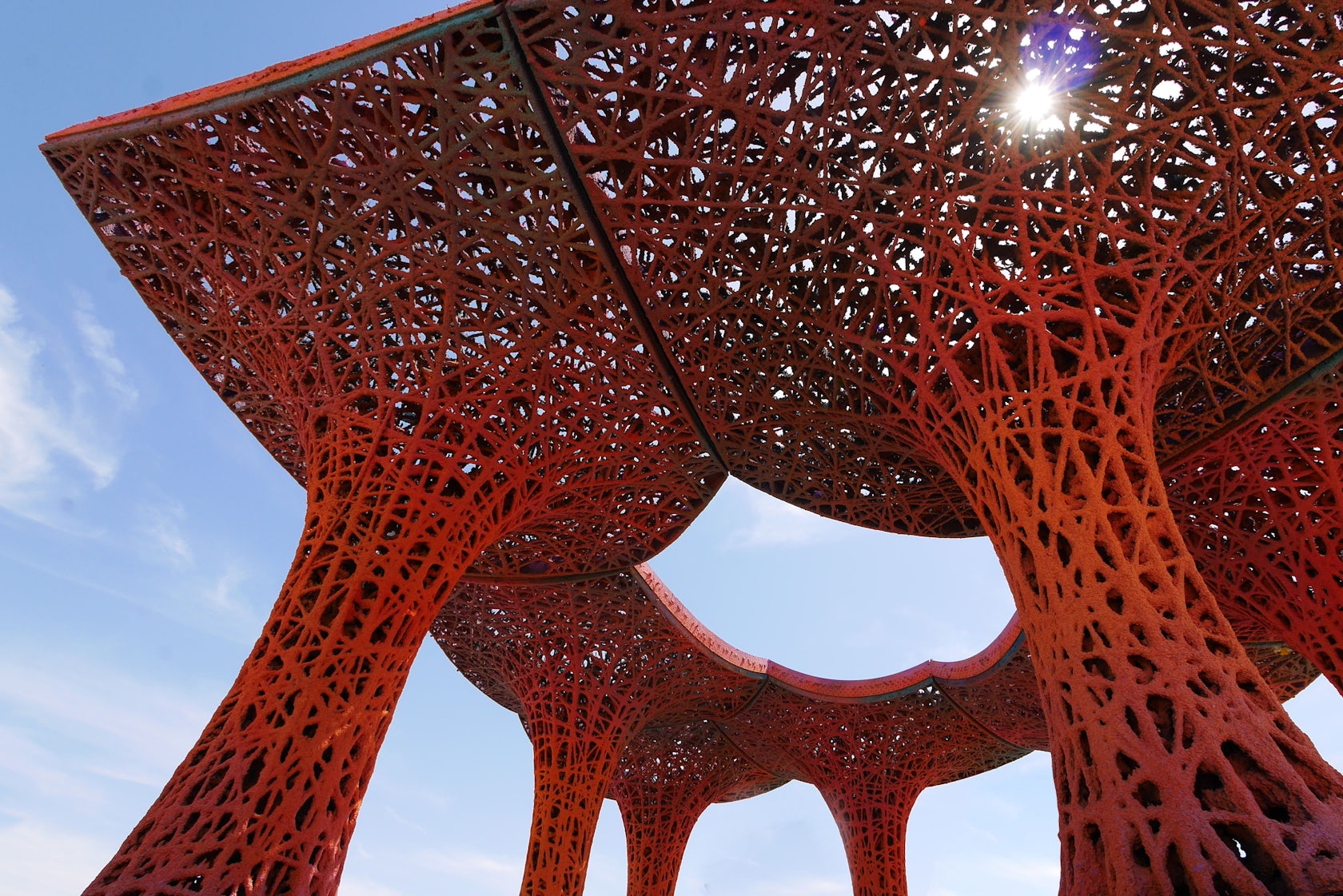New Archetypes is a regular column that explores how architects use modest projects to experiment with new concepts, collaborations, and innovations. These small designs pack a big punch, surpassing the constraints of size, resources, or conventional expectations.
Whatever you do, don’t call them “paper architects.” The Los Angeles-based Ball-Nogues Studio recently designed a 20-foot-tall pavilion composed of an unlikely material: recycled paper pulp. The pavilion, which shaded visitors of the Coachella Valley Art and Music Festival in April, could withstand 85-miles-per-hour gusts of wind. After the festival ended, they exploited paper’s more familiar capability, composting it to return it to the environment. But how did Ball-Nogues elevate paper pulp to a major architectural material? And how does a 20-foot-tall tower of paper — held together with no adhesive — stand up?

© Omar Garza
The Pulp Pavilion began with a playful impulse from the firm’s principals, Benjamin Ball and Gaston Nogues: could they make a shell structure from paper pulp? After producing a small prototype, Ball says they realized paper pulp was “a very beautiful, light, strong, nontoxic, and readily available material capable of assuming many forms. There’s gotta be potential in this.” They experimented further with a series of paper-shell installations, such these glowing sculptural lamps crafted for a Santa Barbara Museum of Contemporary Art exhibition in 2014, and a subsequent experiment for which they seized a model made from strings and sprayed it with the wet paper pulp.
The resulting structure proved strong enough for inspiration to strike: “We thought, why couldn’t you scale this to architecture?” They soon got the chance. Ball describes it as the “perfect storm” of factors: not only a dry, hot, windy climate in which the pulp hardens quickly, but a uniquely adventurous client: Coachella.

© Ball-Nogues Studio
Testing the paper-pulp structure in preparation for the full-scale Pulp Pavilion.
The festival organizers were soliciting proposals for unique pavilions that would shade visitors while surviving the desert environment and the crowds. Ball-Nogues had to experiment extensively onsite to perfect the process — calibrating the pulp mixture to the desert environment — but they produced and tested scale models with engineers to ensure that the project would stand.
So, how does the paper hold together? From packaging to drink trays, all paper products gain their firmnesses from the natural intertwining of paper’s microscopic fibers. Sourced from shredding companies, the material also has another natural advantage: the paper pulp is so compact that its flammability is close to that of dense hardwoods; additional flame-retardant additives reduce that factor even more.

© Corie Saxman

© Forster Rudolph
Meanwhile, the structural system at work on the Pulp Pavilion is remarkably straightforward: several layers of hardened paper pulp encase twine ropes. The pulp works in compression and the rope in tension to create a resilient structure. While the architects do add some adhesive to the mix, it’s not for structural reasons; rather, their experiments revealed a small amount of adhesive helps lubricate during the process of spraying wet pulp.
When it came time to build, the architects first constructed a plywood frame for each tower. That frame, aided by a central truss column, held a rope framework in tension. After spraying on layers of pulp, the truss column was removed and the structure flipped. Once flipped, each tree-like structure could be joined at the top by the remaining outer plywood frames. The structures are some 16 feet wide at their tops, but taper to a mere 38 inches at their bases.

© Ball-Nogues Studio

© Chris Ball
The material’s potential applications could be wide-ranging: from furniture to major architectural elements, the paper is viable so long as it’s shielded from the elements, namely high humidity or moisture. The ability to transform post-consumer waste into a useful structure and compost it at any time presents endless opportunities for temporary applications. For Ball, the other important takeaway is the value of the process that eventually produced the pavilion: simple tinkering. “We had no big picture when we began,” he says, “and that’s precisely why it ended up being successful. It started with a playful untethered exploration of this material that was unbound by the expectations of the architectural discipline.”

© Oliver Walker









